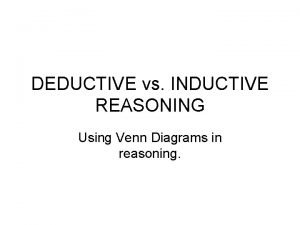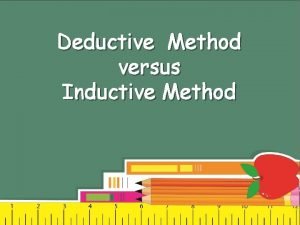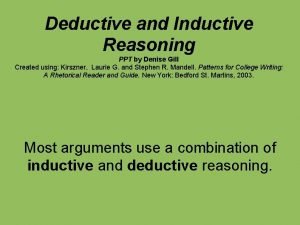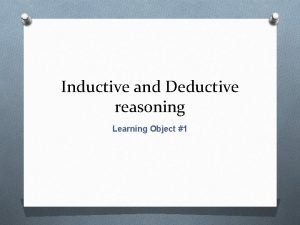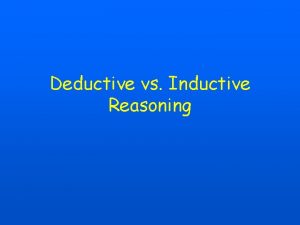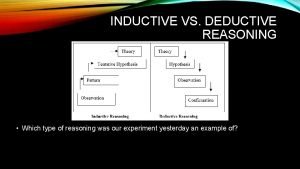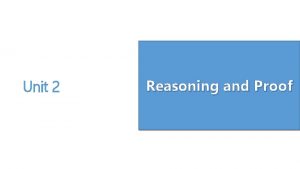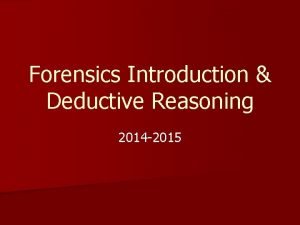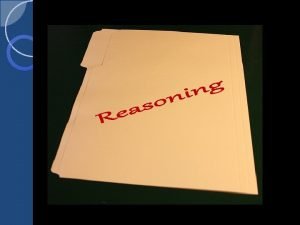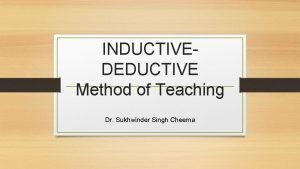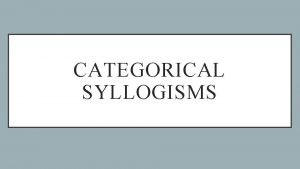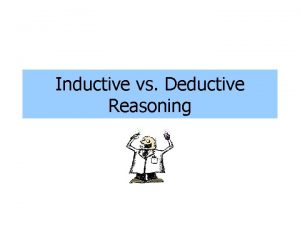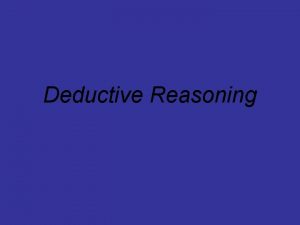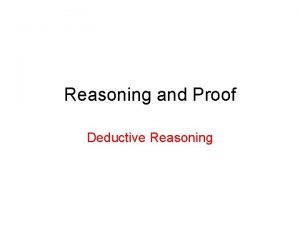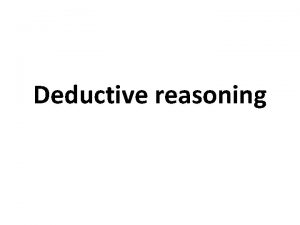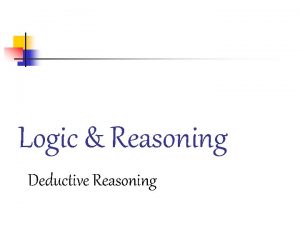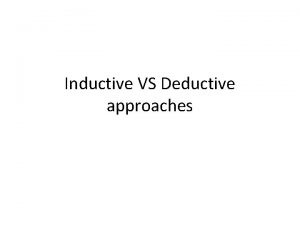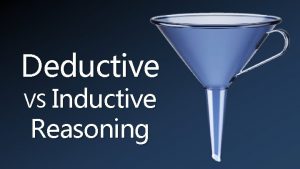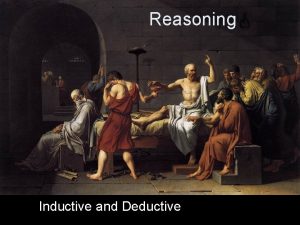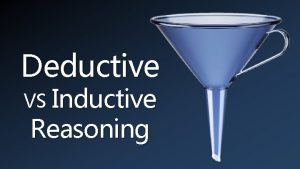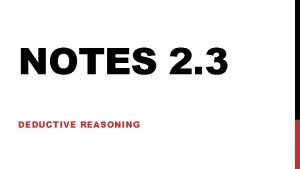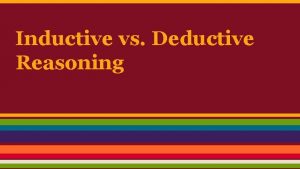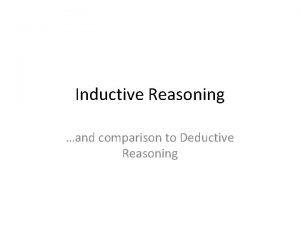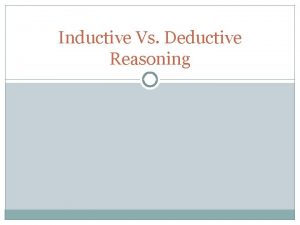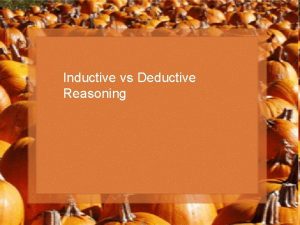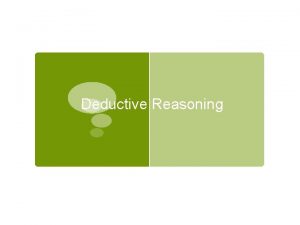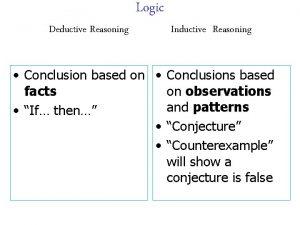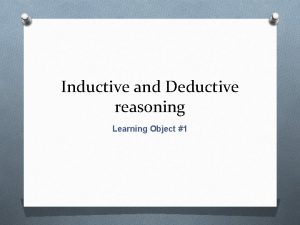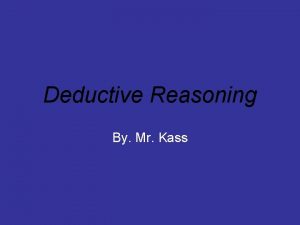Inductive Reasoning The logic of Science Deductive vs

























- Slides: 25

Inductive Reasoning: The logic of Science

Deductive vs Inductive Logic Deductive 1) You try to prove something is certainly true 2) Linked premises Ex: P 1: All humans are mortal P 2: Socrates is human C: So, Socrates is mortal Inductive 1) You try to prove that something is probably (most likely) true 2) Don’t necessarily have linked premises P 1: Smith hates Jones P 2: Jones was killed with Smith’s gun P 3: Smith has no alibi C: Jones, most likely, killed smith

Types of Inductive arguments 1) Enumerative Induction – I observe some sample of a populate and make claims from that sample about the entire population. [beware of hasty generalization] 2) Causal arguments – claiming that X caused Y; or, that there is a causal relationship between X and Y. You have to show that X is capable of causing Y, that X in fact interacted with Y, that Y did not cause X, and that something else did not cause them both. [beware of the causal fallacy (post hoc)] 3) Argument from Analogy – X and Y are alike with respect to A. X also has B, so Y probably has B too.

Enumerative Induction P 1: X Percent of the observed members of group A have Property P C: Therefore, X percent of al members of group A have Property P

Key terms for Enumerative induction Target population (group) – the whole collection of individuals in question Sample (members) – the observed members of the target group Relevant property (property in question) – the property we’re interested in For example: TP = All Swans; SM = Swans we have seen; RP = White feathers. All the Swans that we have seen have white feathers. So, most likely, all swans have white feathers.

Problems Enumerative Inductions 1. Sample Size – If your sample is too small, your conclusion is hasty. 2. Representativeness – your sample must be like the target group by having (1) all the same relevant characteristics, and (2) having them in the same proportions that the target group does. If your sample is not representative, it is a Biased Sample

Analogical Induction P 1: Thing A has properties P 1, P 2, P 3, plus the property P 4 P 2: Thing B has properties P 1, P 2, P 3 C: Therefore, thing B probably has Property P 4

That other people have minds; the animals have feelings P 1: I show emotions, speak, seem to make choices, and I have a mind P 2: Other people show emotions, speak, seem to make choices C: Therefore, other people probably have minds too P 1: We humans, weep, yell, laugh, and we have emotions P 2: Many other animals also weep, yell, and laugh C: Therefore, these other animals probably have emotions too

The design argument for God’s existence P 1: All complex and well organized items (a watch for instance) were designed by intelligent beings P 2: The universe, like a machine, is complex and well-organized C: Therefore, the universe probably was designed by an intelligent being; namely, God.

How do I know that an analogical induction is a good one? There are four criteria: 1. Relevant similarities 2. Relevant dissimilarities 3. The number of instances compared 4. Diversity among the cases

Casual Arguments • Two kinds: 1) X caused Y, and 2) there is a casual relationship between X and Y

Mill’s Methods 1. 2. 3. 4. Agreement Difference Agreement and Difference Correlation

The Case of Elmo’s Bar Bill went to Elmo’s bar ate cheese and drank the wine, and got sick later Emily went to Elmo’s bar, drank the wine and ate crackers and got sick later Tyrone went to Elmo’s bar drank the wine and ate grapes and got sick later Hector went to Elmo’s bar, drank beer, vodka, and wine and got sick later. Kim went to Elmo’s bar, just drank beer, and Kim did not get sick later

Inference to the best explanation • P 1: Phenomenon Q • P 2: E Provides the best explanation of Q • C: Therefore, it is probable that E is true A B E

Near Death Experiences (NDEs) • 1. It’s really afterlife 2. It’s a illusion created by a dying (oxygen deprived) brain

Criteria of adequacy 1. 2. 3. 4. 5. Testability – Can I test the hypothesis? Fruitfulness – Does this hypothesis give us novel predictions? Scope – How much does the hypothesis explain? Simplicity – How many assumptions does the hypothesis make? Conservatism – How well does the hypothesis fit with our best well established beliefs?

Copernicus and the Sun 1543 – Copernicus tells us that the Earth is a planet that goes around the sun - Simplicity 1610 – Galileo makes observations with a telescope that give evince Copernicus was right - Testability

Charles Darwin Born February 12, 1809 (same day and year as Lincoln) Sailed on the HMS Beagle 18311836 Published On The Origin of the Species 1859 Published The Descent of man 1871 Died April 19 1882, aged 73

Theory of Evolution by Natural Selection 1) Organisms reproduce and their reproductions differ a little bit from them (mutation) 2) Some mutations are advantageous in the environment an organism finds itself in, some are not 3) The organisms with an advantage pass on their traits, the one’s without an advantage die off 4) Eventually the changes are big enough that we have a brand new species 5) Given Billions of years, this process can account for all the diversity of life we see today

Evidence for evolution Darwin’s Evidence 1) The Fossil Record 2) Geographic location of various species 3) Comparative Anatomy 4) Artificial Selection Post Darwin Evidence 5) Genes 6) DNA 7) Treating Viruses 8) Embryology

Biblical Creationism vs Evolution through natural selection • Creation • Evolution • God created the world in “ 7 days” in the order the Bible describes it • The Earth is Billions years old. • God created Adam and Eve in their adult state from no prior pre-human state. • Many generations later God destroyed most life on earth in a great flood • Life is Billions of years old. • All life on earth originated with a single common ancestor, some one celled creature. • All life came to be in its presents forms by a mechanical process of evolution by means of random mutation and natural selection

The TEST formula • Step 1: State the Theory and check for consistency • Step 2: Assess the Evidence for theory • Step 3: Scrutinize alternative theories • Step 4: Test theories with the criteria of adequacy

Scientific Terms Hypothesis = an explanation that you can check by testing or observation or both Theory = a hypothesis that has passed the test according to a large majority of scientists. Scientific Truth = You can only prove something is true beyond “reasonable doubt, ” but never with absolute certainty.

Scientific Method 1) 2) 3) 4) 5) Identify the problem or pose a question Devise a hypothesis to explain the event or phenomenon Derive a test implication or prediction from the hypothesis Perform the test (Provisionally) Accept or reject the hypothesis

Science vs. Pseudo-Science Basic Features of Pseudo-Scientific Thinking 1) Relies on Anecdotal evidence – Stories and eyewitness testimony 2) Little if any hard evidence 3) Tends toward “Conspiracy theories. ” 4) Ad Hoc reasoning – trying to reason in such a way that you get a desired conclusion. 5) Thinking that is something seems real, then it must be real. 6) Believing that just because you cannot think of a natural explanation, a phenomenon must be supernatural.
 Inductive reasoning
Inductive reasoning Deductive argument examples
Deductive argument examples Deductive argument examples
Deductive argument examples Deductive logic definition
Deductive logic definition Inductive reasoning vs deductive reasoning geometry
Inductive reasoning vs deductive reasoning geometry Inductive reasoning deductive reasoning
Inductive reasoning deductive reasoning Deductive and inductive reasoning venn diagram
Deductive and inductive reasoning venn diagram Inductive vs deductive method of teaching
Inductive vs deductive method of teaching Inductive and deductive reasoning ppt
Inductive and deductive reasoning ppt Example of deductive reasoning
Example of deductive reasoning Logic induction
Logic induction Deductive and inductive reasoning venn diagram
Deductive and inductive reasoning venn diagram Inductive vs deductive reasoning
Inductive vs deductive reasoning Statistical syllogism example
Statistical syllogism example Inductive reasoning is reasoning based on patterns
Inductive reasoning is reasoning based on patterns Unit 2 logic and proof inductive reasoning
Unit 2 logic and proof inductive reasoning Example of a deductive argument
Example of a deductive argument Deductive reasoning definition forensic science
Deductive reasoning definition forensic science Inductive logic
Inductive logic Deductive inductive
Deductive inductive What is inductive and deductive method of teaching
What is inductive and deductive method of teaching What is conceptual learning
What is conceptual learning Inductive learning
Inductive learning Standard argument form
Standard argument form Is the teleological argument inductive or deductive
Is the teleological argument inductive or deductive Audio lingual method deductive or inductive
Audio lingual method deductive or inductive






